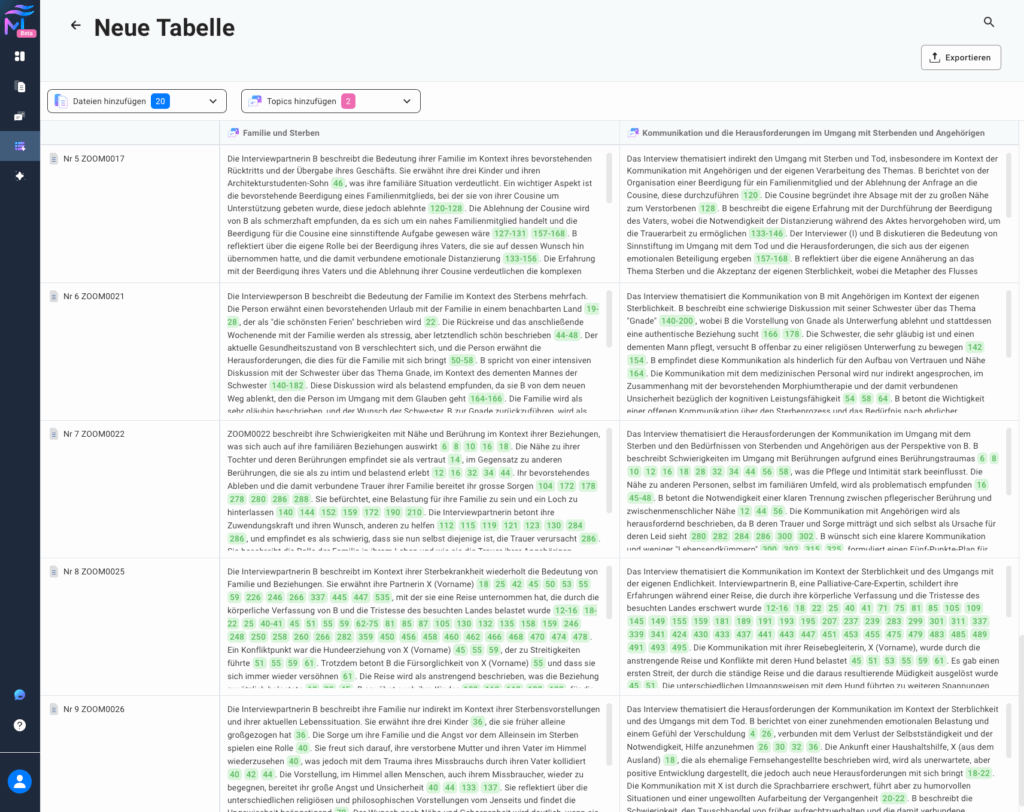The Development of AI for Qualitative Research: First Experiences with MAXQDA Tailwind

Prof. Dr. rer medic. André Fringer PhD
ZHAW School of Health Sciences
- Nursing Researcher, Health and Care Scientist
- Head (Co-Head) Research & Development Nursing
- Programme Director (Co-Head) MSc Nursing
Looking back on my decades of experience and practice with MAXQDA, and my self-understanding as a qualitative researcher, I initially felt deeply unsettled by the emergence of AI technologies—particularly ChatGPT and, subsequently, MAXQDA Tailwind. My skepticism was significant: if the researcher is the central analytical instrument, as required by the social-constructivist and interpretive paradigm, it seemed challenging to integrate machine-based support meaningfully. At first, I feared that only quantitative research logics would be affected mainly. However, it soon became clear that qualitative analysis processes were also increasingly accelerated—and in some cases even surpassed—by AI. This generated ambivalence: fascination with the analytical efficiency, yet also concern about my professional relevance.
AI for Qualitative Research as Peer Support
Through exchanges with students and as I gained deeper experience, my understanding evolved: AI is not a replacement, but rather a form of support. Tools like MAXQDA AI Assist or MAXQDA Transcription can take over highly time-consuming tasks. Still, they do not substitute for the researcher’s interpretive judgment. Just as I routinely assume responsibility in student projects—even when the empirical material has been formally processed—I must retain full analytical accountability when working with AI-generated suggestions. Machine transcription provides a usable first draft, but it cannot replace the conscious act of listening and interpreting interpersonal nuances. The same applies to analytical proposals: helpful, but never authoritative.
Today, I consider AI for qualitative research as a new “peer” in the analytical process—a partner who neither replaces nor diminishes me, but rather helps focus and refine my work. In this role, AI is not the leading actor, but rather an intelligent counterpart in an analytical dialogue. The tool MAXQDA Tailwind, for instance, exemplifies how a simple data overview can evolve into a more structured analytical pathway. The development is not disruptive, but iterative; existing in the dynamic tension between relief and renewed responsibility.
Working with MAXQDA Tailwind
Below, I outline my initial experiences with the web-based tool MAXQDA Tailwind. According to the company, MAXQDA Tailwind supports researchers in structuring extensive documents, identifying core themes, and generating theme-specific summaries to achieve a deeper understanding of the data. My use of the tool took place within an ongoing research process analyzing the experience of a palliative care expert.
The database consists of 20 narrative in-depth interviews conducted at regular intervals of four to six weeks. Each conversation lasted between 60 and 90 minutes and was initiated by open narrative questions such as “Tell me how you’re doing?” or “What would you like to share with me?” The methodological orientation follows Wengraf’s (2001, 2021) Narrative Biographical Interpretative Method (BNIM), which distinguishes between the lived biography, the narrative story, and the social interpretation.
Throughout the analysis, six central narrative threads emerged like the biographical trajectory, including childhood and youth in Zurich or the professional development of a specialized palliative care service. MAXQDA Tailwind proved exceptionally useful in this context for stematically making thematic condensations visible without relinquishing interpretive responsibility.
Before beginning the inductive line-by-line coding process, it is advisable to conduct a preliminary analytical step using MAXQDA Tailwind. The function Find Topics opens an exploratory perspective on the material, particularly effective in uncovering previously “hidden” thematic areas and phenomena. It is precisely in this dialogic quality that the peer-like character of AI-based tools becomes evident, not as a substitute, but as an epistemologically expanding counterpart. Additionally, users can define their topics, for example, based on previously developed thematic fields. This enables the identification of cross-cutting thematic and structural patterns across all interviews.
Particularly noteworthy is the MAXQDA Tailwind Summary Tables feature. It allows researchers to systematically visualize thematic developments across the entire dataset: a type of analytical access that traditionally becomes available only after full coding is completed. Themes can thus be analyzed not just at isolated points, but longitudinally. The tabular representation over 20 months enables a sensitive reconstruction of narrative development lines, especially valuable in studies with temporally spaced interviews.

For the BNIM methodological approach, a technical detail proved crucial: the sequential numbering of interview transcripts must be formally structured in a way that preserves chronological order, such as using leading zeros (01, 02, …), so that this sequence remains intact in the Summary Tables.
MAXQDA Tailwind is not a tool for merely accelerating qualitative analysis processes, but rather a methodological extension. The exploratory examination of the data is deepened, allowing blind spots to be made visible and previously hidden connections to be traced. For the biographical narrative interpretive method (BNIM), MAXQDA Tailwind represents a potentially significant additional tool, not as a technological gimmick, but as a serious addition to a methodically controlled analysis practice.